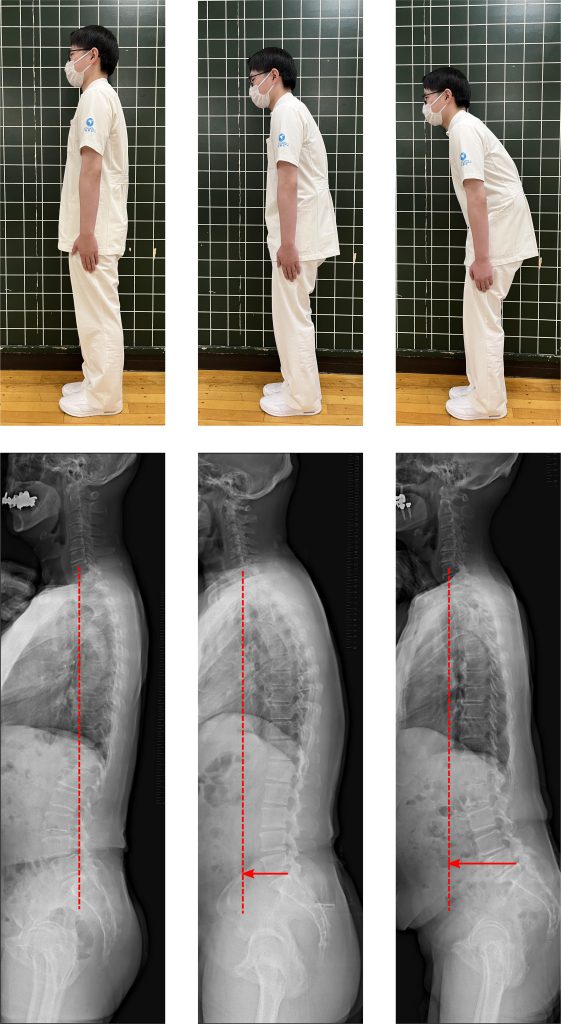
The spinal column posture was evaluated by the examination. The left shows the posture in which the anterior-posterior balance of the spinal column is balanced, and the center and the right are the upper body protruding forward with respect to the pelvis and the center of gravity forward. As we get older, the center of gravity tends to move forward. By evaluating this, it is possible to detect a slight decline in cognitive function. Credit: Nishimura, H., Ikegami, S., Uehara, M. et al.
Examining posture during a health check could identify cognitive decline.
The question of whether cognitive decline may be identified by sagittal spinal balance assessment based on a radiological approach was investigated via a large-scale survey of persons aged 50 to 89 years. Shinshu University researchers discovered links between sagittal vertical axis (SVA) anteriorization and older age and worse cognitive performance. The distance between the posterior superior sacral end plate to a vertical plumbline dropped from the centroid of the C7 vertebral body is known as the sagittal vertical axis.
Subjects are more likely to have signs of moderate cognitive decline the more the head and neck protrude in front of the pelvis when seen from the side (the greater the length). In men, the SVA was linked to age-independent cognitive decline. Cognitive decline was more prevalent in females with SVA equal to or more than 70mm, regardless of age.
Mild cognitive impairment is defined as cognitive complaints from the person or others but no dementia. In areas where costly specialized testing equipment or additional medical testing time is restricted for the senior population, dementia, frailty, and bedridden condition may be avoided by detecting moderate cognitive impairment at a reversible stage.
Hikaru Nishimura, the first author, is an occupational therapist who studies issues encountered by the elderly from a rehabilitation viewpoint. In older adults, exercise training may lessen or even stop the progression of dementia.
Corresponding author Doctor Shota Ikegami of Shinshu University states that poor posture is a manifestation of “frailty” in the elderly. Hidden cognitive decline, a component of frailty can be detected by posture screening. Older adults in the town of Obuse, Nagano were examined for the mass survey. It was found that in Japanese older adults, those who exhibited anteriorization of the spine were more likely to also have cognitive function decline.
Cognitive decline was reliably detected by combining age and the degree of spinal imbalance. Males with SVA ≥ 100 mm at any age, SVA ≥ 90 mm at ≥ 70 years, and SVA ≥ 70 mm at ≥ 80 years were likely to have cognitive decline, while females with SVA ≥ 70 mm at any age are likely to have cognitive decline.
The prefecture of Nagano boasts some of the highest health longevity in Japan. With this study and others, doctors hope to prevent future need for care through rehabilitation interventions for frailty found during screenings.
Reference: “Detection of cognitive decline by spinal posture assessment in health exams of the general older population” by Hikaru Nishimura, Shota Ikegami, Masashi Uehara, Jun Takahashi, Ryosuke Tokida, and Hiroyuki Kato, 19 May 2022, Scientific Reports.
DOI: 10.1038/s41598-022-12605-7
The study was funded by the Japan Orthopaedics and Traumatology Research Foundation, Inc., the Shinshu Public Utility Foundation for Promotion of Medical Sciences, the Japanese Society for Musculoskeletal Medicine, the Shinshu University Hospital, and the Nakatomi Foundation.









“As we get older, the center of gravity tends to move forward. By evaluating this, it is possible to detect a slight decline in cognitive function.”
They have stated the obvious, which is that there is a correlation between aging, cognitive decline, and posture. Whether they have demonstrated anything unique depends on how well the test they used differentiates normal cognitive decline from dementia. It may be that the cognitive decline is responsible for the change in posture, but they apparently didn’t attempt to determine the cause-effect relationship.
That’s why I don’t like being in cars, if you don’t keep the backrest straight up it messes up your posture.
Isnt the next step to do a study of graduates of West Point or other military academies that instill exceptional posture, to see if there are lower rates cognitive decline due to postural decline?
A very interesting study, so some thoughts for rumination/discussion:
Like most, if not all, of the experimental studies it is virtually impossible to delineate a cause-effect relationship between SVA and cognition decline. But the inverse relationship between age and SVA (in mm) that is required to show declines in cognition, it seems to suggest that SVA causes cognition declines because a smaller SVA is required to show cognition decline at older ages where cognition is generally lowered, i.e. more vulnerable to SVA. At younger ages like 50 a declined cognition is not seen at SVA of 70 mm or 90 mm until 100 mm, i.e. less vulnerable to SVA. Conversely, saying declined cognition at age 50, which is less likely, results in SVA of 100 mm is hard to believe, or untenable.
Or, there is simply no cause-effect relation.
The former guy isn’t going to like this.